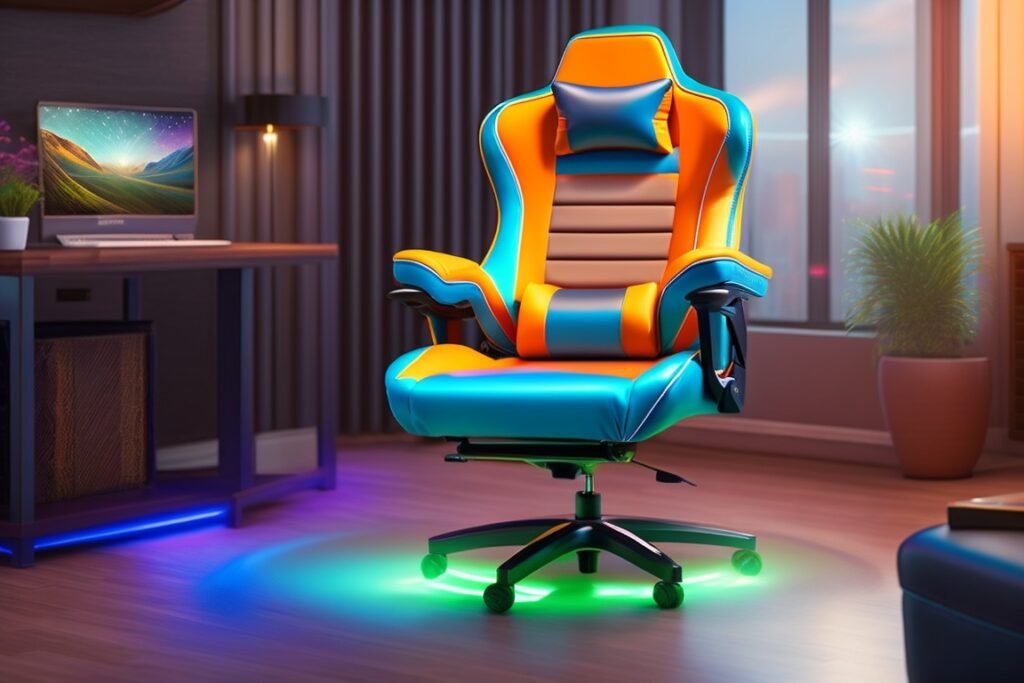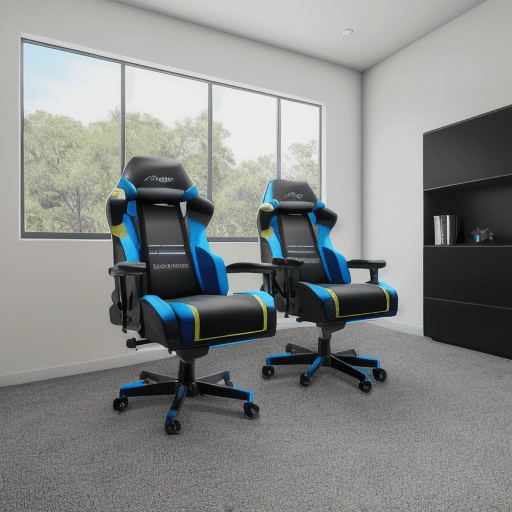Ergonomics is the science of designing and arranging items people use so that the person, environment and equipment interact most efficiently and safely.

In regards to workplace ergonomics, lumbar support plays a vital role in helping maintain correct posture and reducing discomfort associated with prolonged sitting.
This article will discuss the importance of lumbar supports for improved physical comfort, increased productivity and reduced risk of injury or chronic pain.
Incorporation of appropriate lumbar support into workstation design has been shown to reduce stress on muscles, ligaments and joints around the lower back area as well as improve spinal alignment during activities such as typing or using a mouse.
Additionally, having an adjustable chair with adequate lumbar support can lead to increased satisfaction at work by providing employees with better postural control while performing their tasks.
This ultimately results in fewer distractions due to discomfort, allowing individuals to stay focused on their work for longer periods of time.
Understanding Ergonomics
Ergonomics is the science of designing tailored workspaces and adjustable seating that best help people work efficiently and comfortably. It seeks to create a harmony between the worker, their environment, and the tools they use.
Just as an orchestra requires its instruments to be tuned in order to produce beautiful music, ergonomic design strives for an optimal balance of elements in order to keep workers productive and healthy.
In terms of office furniture, this often means chairs with customizable backrests equipped with lumbar support cushions or other devices designed to reduce strain on the lower spine. By providing proper posture alignment when sitting down for extended periods of time, these supports can significantly reduce fatigue and improve overall wellbeing.
Though it may not always seem like a priority, ergonomics plays an important role in creating comfortable workplaces that are both safe and conducive to productivity. When considered carefully, even small changes such as adjusting chair heights or adding lumbar support can have far-reaching benefits for employees’ quality of life at work.
The next section will explore the specifics regarding why lumbar support is so important when implementing ergonomic design principles.
The Role Of Lumbar Support
Lumbar support plays an essential role in ergonomics. It helps to improve circulation, prevent fatigue and maintain correct posture while working or sitting for extended periods of time.
Lumbar supports are designed to provide additional support along the natural curvature of your spine to reduce strain on your lower back muscles. Usually made from soft foam padding that can be adjusted according to height and comfort levels, lumbar supports offer extra cushioning to help promote good posture and keep you more comfortable throughout the day.
When used correctly, lumbar supports can help reduce stress on the lower back muscles, improve alignment between vertebrae, encourage proper position when seated or standing, alleviate pressure points caused by improper seating positions and minimize overall pain associated with poor posture.
Additionally, improved circulation resulting from a properly supported lower back may help increase energy levels and decrease feelings of general fatigue throughout the day. The key is finding a suitable solution that offers adequate support without sacrificing comfort.
Choosing adjustable options such as lumbar pillows or cushions allows users to personalize their level of comfort while ensuring they remain in proper positioning during activities like typing at a desk or driving long distances. Taking proactive steps towards improving one’s postural health will go far in keeping the body healthy and energized over time.
Transitioning into maintaining correct posture is paramount for optimal results in both physical and mental wellbeing.
Maintaining Correct Posture
The importance of lumbar support cannot be overstated when it comes to maintaining correct posture. Lumbar support is a key factor in proper seating, as without the right amount of cushioning and support the spine can become misaligned while sitting for an extended period of time. This will result in unnecessary pressure being applied to certain areas, which can lead to pain or discomfort throughout the day.

There are several strategies one can employ to ensure that their lumbar support remains effective:
- Adjust chair height so that feet remain flat on floor and thighs are parallel with ground.
- Ensure backrest reclines enough to provide adequate lower back comfort but not too far forward to cause neck strain.
- Use cushions or pillows between lower back and seatback for additional comfort if needed.
By following these steps, individuals are able to reduce discomfort and pain caused by improper posture while simultaneously improving overall spinal health long-term. It is important to note that even minor adjustments can have major implications when it comes to preventing bodily harm due to poor ergonomic practices.
Moving forward, understanding how best to use lumbar support is essential in order create optimal working conditions in any environment.
Reducing Discomfort And Pain
Proper lumbar support is essential for reducing discomfort and pain caused by extended sitting. Ergonomically designed furniture, such as adjustable chairs, can help to provide the necessary support.
Such chairs typically feature a supportive backrest that follows the natural curve of the spine and an adjustable seat pan that allows users to adjust its height relative to their own body size. Supporting one’s lower back with properly adjusted furniture ensures ergonomic principles are being followed which helps limit stress on muscles and joints in this area.
In order to maximize comfort while sitting, many adjustable chairs include features such as tilt tension control or center-tilt mechanisms for adjusting the angle of recline. Additionally, these chairs should have arm rests that allow your forearms and elbows to rest comfortably at 90 degrees when typing.
Upholstered material also plays a role in providing additional cushioning during prolonged periods of sitting. All these elements combined create an optimal environment for supporting proper posture while seated.
When selecting seating options, it is important to consider both style and function so you can find something comfortable yet supportive enough to meet your needs over time. Adjustable furniture provides numerous benefits including customizable settings which makes them ideal solutions for anyone looking for reliable lumbar support.
With careful consideration given towards selecting appropriate seating arrangements, office workers will be well equipped with the tools needed to reduce discomfort and pain associated with long hours spent at their desk. Moving forward into improving spinal alignment…
Improving Spinal Alignment
The importance of lumbar support in improving spinal alignment cannot be overstated. Proper positioning is key to ensuring a healthy posture, as an ergonomic design can reduce the risk for musculoskeletal issues while providing optimal comfort and productivity.
It is essential that any desk or chair provide adequate back support in order to ensure correct posture and prevent lower back pain. A good office chair should adjust easily to fit one’s body size and shape, with adjustable height, tilt control, armrests, seat depth and headrest features so each user may customize their own setup. The ideal position encourages proper posture by supporting the natural inward curve of the lower spine along with keeping hips higher than knees when seated at a desk.
When establishing lumbar support it is important to take into account factors such as individual body type and sitting habits. To avoid strain on the neck and shoulders, elbows should rest comfortably at ninety degrees when typing and wrists should remain straight while using the mouse or keyboard. Additionally, frequent breaks are recommended every thirty minutes to encourage movement which helps relieve tension from sustained positions throughout the day.
By following these guidelines users will experience improved comfort levels during work sessions through increased mobility and reduced stress on joints associated with repetitive tasks. By optimizing lumbar support we create an environment conducive to increasing productivity with less fatigue caused by improper postural habits.
Taking proactive measures against poor health outcomes due to prolonged sitting increases wellbeing among employees who use computer-based technology regularly for extended periods of time. With better understanding of ergonomics principles individuals can make informed decisions about how best they can stay comfortable while working without sacrificing performance or placing themselves at greater risk for injury.
Increasing Productivity
After discussing the importance of spinal alignment, it is now time to focus on increasing productivity in the workplace.
Most people are familiar with how prolonged sitting can be detrimental for both physical and mental health; however, there are several steps that one can take to reduce risk of injury while being productive at work.
First, adopting healthy habits such as taking regular breaks away from computer screens throughout the day will help to alleviate any stress or tension placed on the back.
Secondly, ensuring that chairs are properly adjusted by raising or lowering them according to individual body type will create a more comfortable position for working over extended periods of time.
Thirdly, adding lumbar support as an additional ergonomic feature helps maintain proper posture which reduces strain on muscles and nerves around the spine area.
Lastly, using standing desks or desk converters instead of traditional desks may provide further relief for those who have difficulty finding comfort when seated over long stretches.
These strategies all contribute to creating a healthier environment where workers can operate with greater efficiency and remain free from any pain or discomfort associated with improper seating arrangements.
As we move forward into our next section about reducing risk of injury, this knowledge should become even more essential in order to promote a safe and sustainable workspace.
Reducing Risk Of Injury
The importance of lumbar support cannot be understated when it comes to reducing risk of injury. It is essential for ergonomic specialists to ensure that individuals are properly outfitted with the right chair and other supportive aids in order to maintain a healthy posture while at work or home.
Exercising safely, as well as proper stretching, can help minimize any risks associated with poor postural positioning from prolonged sitting. Stretching should include regular breaks throughout the day, focusing on the spine and its surrounding muscles. This will enable users to remain in an upright position without straining their back muscles and ligaments. Additionally, exercising regularly can also aid in strengthening core muscles which play an important role in providing spinal stability and protection against injury.
Creating an environment designed around user comfort helps maximize productivity while minimizing stress-related musculoskeletal issues that may arise from incorrect posture or ill-fitting equipment. The use of adjustable chair heights, arm rests, footrests, and appropriate lumbar supports can all contribute to creating a safe workplace where workers feel comfortable yet energized to perform their tasks efficiently and effectively.
By taking proactive steps towards maintaining good posture and incorporating exercises into daily routines, users can significantly reduce the chances of developing chronic pain due to improper body mechanics or postures sustained over extended periods of time. With this knowledge in hand, we now turn our focus towards enhancing satisfaction at work.
Enhancing Satisfaction At Work
The importance of lumbar support in the workplace cannot be overstated. In recent years, a growing number of organizations have begun to recognize its impact on enhancing employee satisfaction and productivity.
For example, one large software company installed adjustable chairs with built-in lumbar support for all of their employees as part of an effort to create a healthier work environment.
Ergonomics specialists recommend that employers provide alternate seating options such as exercise balls or balance discs along with adjustable chairs so that workers can customize their sitting position to best fit their individual needs. Such solutions allow individuals to find the most comfortable posture while still providing adequate lumbar support during long periods of seated work.
Furthermore, having access to multiple types of seating encourages employees to take regular breaks from sitting throughout the day which further promotes healthy habits at work and improved overall wellbeing.
Employers who invest in ergonomic office furniture are likely to see significant returns in terms of increased job satisfaction and productivity among their staff members. A well-designed workspace should prioritize comfort and function while also taking into account each person’s unique physical needs when it comes to lumbar support.
With thoughtful investments in ergonomically designed furniture, businesses can create an environment where employees feel supported and empowered to do their best work.
Frequently Asked Questions
How Do I Know If I Need Lumbar Support?
When considering the Current Topic of how to know if you need lumbar support, ergonomic chairs and posture reminders can be effective solutions.
Ergonomic chairs are designed with adjustable components such as armrests and seat height that make it easier for people to adjust their position while sitting.
Posture reminders will provide visual cues that alert one when they have been in a sedentary position too long or adopted poor posture.
Additionally, individuals should pay attention to any discomfort they may feel in their back region; this could indicate that additional lumbar support is necessary.

How Often Should I Adjust My Lumbar Support?
Ergonomic chairs are designed with adjustable lumbar support to provide comfort and reduce fatigue.
To ensure optimal comfort, the user should adjust their chair’s lumbar support at least once per day while seated in the chair.
It is also recommended that users perform back stretching exercises every hour or two throughout the workday.
Properly adjusting and using lumbar support on an ergonomic chair can help reduce physical strain while sitting for long periods of time.
How Do I Know If I’m Sitting In The Correct Posture?
The right posture is essential for optimal comfort and health. Ergonomic chairs, combined with regular posture exercises, are some of the best ways to maintain your body in its correct alignment.
Sitting up straight at all times can be difficult without a supportive backrest such as lumbar support; however, there are certain signs that you have assumed proper ergonomics.
Your feet should always rest flat on the floor while your thighs should stay parallel to it when sitting down. Additionally, shoulders should be relaxed and arms positioned so that your forearms remain parallel to the ground.
Keeping these simple guidelines in mind will ensure that you enjoy longer hours of work or leisure activities without strain or discomfort.
What Type Of Lumbar Support Is Best For Me?
Ergonomic design and stretching exercises are essential to finding the best type of lumbar support for an individual.
The ergonomics specialist must consider a variety of factors when selecting the most suitable lumbar support, as it is designed to provide comfort and stability while sitting in different postures.
Moreover, the correct lumbar support should be adjustable so that individuals can adjust its height, width, depth and firmness according to their needs.
As such, there is no one-size-fits-all solution; rather each individual must identify a lumbar support that fits their lifestyle best.
How Long Should I Sit With Lumbar Support For?
Sitting with lumbar support is an important part of any ergonomic setup, as it helps to reduce pain and fatigue associated with sitting for long periods.
To get the most out of your design and posture tips, you should aim to sit in a position that allows for proper spinal alignment while providing adequate lumbar support.
Depending on the type of chair or cushion you use, experts recommend sitting no longer than 30 minutes at a time before taking a break or standing up to stretch.
It’s also wise to choose from among the many available ergonomic options such as adjustable chairs, back cushions, and seat wedges which can help provide optimal comfort and support throughout the day.
Conclusion
Proper use of lumbar support is essential for maintaining good posture and avoiding back pain.
As the adage states, ‘An ounce of prevention is worth a pound of cure.’
Appropriate positioning with lumbar support helps to ensure proper alignment and minimize pressure on the spine, neck, and shoulders that often leads to discomfort and chronic conditions.
When choosing what type of lumbar support works best for each individual, it is important to consider one’s lifestyle, body shape, habits at work or home, and existing medical conditions.
Ultimately by using lumbar support correctly according to individual needs as well as taking frequent breaks from sitting can make all the difference in preventing costly health issues in the future.

Sha Neumeister, the visionary behind SomosVisibl.com, is a connoisseur of gaming chairs that prioritize both style and comfort. With an unparalleled understanding of ergonomics and a passion for enhancing the gaming experience, Sha curates a collection of gaming chairs that offer impeccable support and aesthetic appeal. Elevate your gaming setup with Sha’s handpicked selection of gaming chairs, designed to keep you comfortable and immersed in your virtual adventures.








